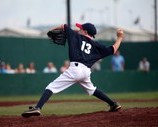
So Your Young Son Wants to Pitch in the Major League
 So your young son wants to pitch in the Major League some day. The secret to failure is burly success. No one who will make it to the big league as a pitcher was very successful pitching at Little League or in Babe Ruth.
So your young son wants to pitch in the Major League some day. The secret to failure is burly success. No one who will make it to the big league as a pitcher was very successful pitching at Little League or in Babe Ruth.
There are 1000 ways to throw a baseball, but only one correctly. Youngsters rarely have the physical and mental aptitude to apply correct pitching mechanics. They lack balance, leg strength and shoulder deceleration, to name just a few. Inadequate follow through, throwing the ball across the body or with the hand under the ball in full cocking phase, are more frequently seen problems.
But if they are successful at striking out opponents at a young age, despite poor mechanics, then they will pitch more games and develop more habits until their shoulder and elbow fails. It happens every time. It is not just the coach over pitching the youngster, but the player himself, or parent, or teammate who encourage the youngsters malpresence because of previous success.
To be a successful pitcher at the college level or beyond, don’t pitch.
Learn proper mechanics. Learn to reproduce your release position so as to improve accuracy. Remember, pitching has three important aspects just like real estate. They are location, location, location.
When you do pitch, don’t worry about striking out every opponent. It is probably more important at the early stages of pitching to learn to play defense off the mound. When you do pitch, no curve balls before the age of 17. Just work on locating your fastball and maybe a changeup.
Never pitch more than one game per week, never more than 50 pitches per game for little league and 70 pitches per game for older Babe Ruth or high school players. When not pitching, don’t play catcher – the shoulder has only so many throws in it, save them for later.
Plus, don’t play on three different travel teams and don’t play year round. Be involved in other activates, especially your school work.
By age 17, your son should have reached the physical and mental maturity to have developed and maintain good pitching mechanics. His shoulder decelerators are strong enough to prevent shoulder and elbow problems and he is probably ready to throw a proper curve ball, not that risk twisting Little League curve.
For more information contact me, Dr. Mark Chilton or Randy Krebs, P. T. for group sessions in pitching mechanics.